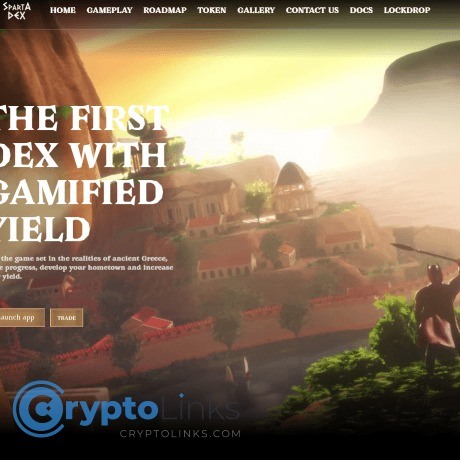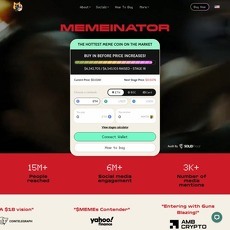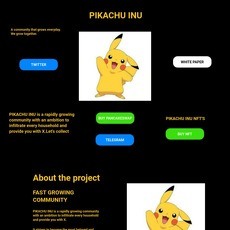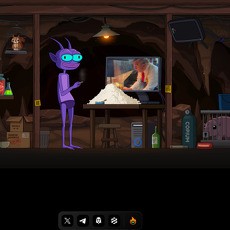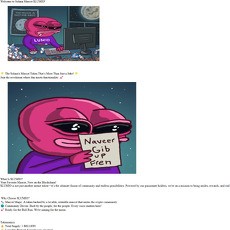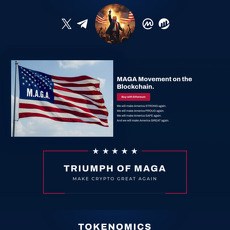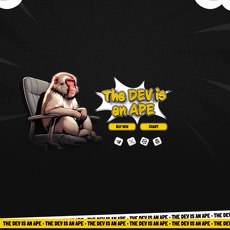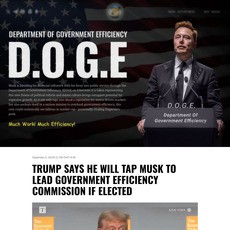The town where the game takes place is called polis. Polis literally means “city” in Greek. It is an autonomous city-state in ancient Greece ruled by the citizens themselves.
Polis is the NFT. By minting it you can start playing SpartaDEX. But the only way to progress further and start to upgrade your polis is to add a minimum of $100 of liquidity into the one of the whitelisted pools.
In this NFT, all progress and development of the Polis, all achievements, building levels, research, units are saved. Thanks to this form, highly developed settlements gain additional value and can be sold on the secondary market. Polis with a high level of Senate generate higher APR from LP staking, which translates into their value.
You can leave our DEX, sell your NFT and withdraw liquidity, but remember that such action is subject to a cooldown period or charging a fee (Surrender Tax)*, the value of which remains locked in the pool, increasing the liquidity of a given project forever. This builds a stable and deeper liquidity over time.
The same rules apply to the withdrawal of any liquidity pool in the SpartaDEX ecosystem.
Spartans NFT Collection
The legendary stories of Sparta are not solely attributed to the city itself, but mainly to its people - the indomitable heroes whose incredible deeds have been immortalized. The Spartans NFT Collection pays tribute to these heroes who are still celebrated for their courage, bravery, tenacity, and strength. It’s also them who form the very foundation of SpartaDEX ecosystem.
Spartans NFT the crucial collection, not only serving as lovely PFP, but also playing the key role in the SpartaDEX ecosystem. The full capabilities and benefits of the NFTs will be unveiled gradually as additional protocol functionalities are implemented.
The collection is characterized by a number of utilities and provides incentives unavailable in any other way. Some of them are available to holders at the very beginning of SpartaDEX development, others will be revealed and fully used only at later stages.
The Spartans NFT utility includes:
the ability to participate in special quests that diversify the gameplay and provide in-game rewards;
access to the multiplayer mode planned for implementation in Q4 2023;
share in the airdrop of native exchange token - $SPARTA
participation in IDOs on SpartaPad (SpartaDEX launchpad)
...and much more to come!
Spartans NFTs have different levels of rarity — Hoplite, Spartan and God.
Both revealed and unrevealed Spartans are available on OpenSea marketplace:
Revealed Spartans:
Unrevealed Spartans:
Unrevealed Spartans NFT mint:
The mint of the collection took place on April 5, 2023. The entire collection was minted, no NFTs were burned. Here are some key details regarding the minting process:
Network: Arbitrum
NFT supply: 5555 (Community: 5300, Treasury: 255)
Type: First-come-first-serve
Whitelist eligibility: 3 NFTs
WL phase minting window: 5th of April, 5:00PM — 9:00PM (UTC)
Public phase minting window: 5th of April, 9:00 PM — 6th of April, 9:00 PM (UTC)
Minting cost:
— WL: 0.06 ETH
— Public: 0.075 ETHSenate
The Senate is the most important and at the same time the most functional building in the entire SpartaDEX game. It is actually the command center of the entire ecosystem and the place where offchain and onchain functions interwine. Here all actions related to financial management, voting and receiving prizes take place.
The main functions of the Senate include:
LP staking management;
voting on protocol development proposals within the DAO;
claming airdrop rewards;
NFT claim (both Polis NFT and Map NFT);
Single Asset Staking management;
adding liquidity pools;
Senate in-game model
More information and technical details about these mechanisms are in the Get Started section.Market
The marketplace is where all trade transactions take place. Both onchain and offchain.
Swaps
Exchange of tokens available on Arbitrum.
Micropayments
Exchange of $SPARTA tokens for premium currency - Gems.
Resources market
Purchasing resources for gems. The higher the Market level, the better the gems to resource ratio
More information and technical details on the exchange mechanisms in the Get Started section.
Market in-game model
Functional buildings
In addition to the two most important buildings presented above, there are a number of others that have specific functions and tasks in the game world. Most of these buildings can also be upgraded, improving their stats and gameplay impact. The level of all buildings is linked to the level of the Senate - the maximum level of the building to which it can be upgraded cannot exceed the current level of the Senate.
Mining Buildings
Their main task is to gather resources.
There are three mining buildings:
Gold mine
Lumber camp
Quarry
With each level of development of the building, the production volume and its storage capacity increase.
The table below shows the production depending on the level of the building:
Level
Quarry (units/h)
Lumber camp (units/h)
Gold mine (units/h)
1
390
420
18
2
405,76
436,97
18,73
3
430,59
463,71
19,87
4
466,09
501,94
21,26
5
498,71
537,07
22,75
6
533,62
574,67
24,35
7
570,98
614,9
26,05
8
610,94
657,94
27,87
9
653,71
704
29,82
10
699,47
753,27
31,91
11
748,43
806
34,15
12
800,82
862,42
36,54
13
856,88
922,79
39,09
14
916,86
987,39
41,83
15
981,04
1056,51
44,76
16
1049,72
1130,46
47,89
17
1123,2
1209,59
51,24
18
1201,82
1294,27
54,83
19
1285,95
1384,87
58,67
20
1375,96
1481,81
62,78
21
1472,28
1585,53
67,17
22
1575,34
1696,52
71,87
23
1685,61
1815,28
76,9
24
1803,61
1942,35
82,29
25
1929,86
2078,31
88,05
26
2064,95
2223,79
94,21
27
2209,5
2379,46
100,81
28
2364,16
2546,02
107,86
29
2529,65
2724,24
115,41
30
2706,73
2914,94
123,49
31
2896,2
3118,98
132,14
32
3098,93
3337,31
141,38
33
3315,86
3570,92
151,28
34
3547,97
3820,89
161,87
35
3796,32
4088,35
173,2
36
4062,07
4374,53
185,33
37
4346,41
4680,75
198,3
38
4650,66
5008,4
212,18
39
4976,21
5358,99
227,03
40
5324,54
5734,12
242,93
41
5697,26
6135,51
259,93
42
6096,07
6564,99
278,13
43
6522,79
7024,54
297,59
44
6979,39
7516,26
318,43
45
7467,94
8042,4
340,72
46
7990,7
8605,37
364,57
47
8550,05
9207,74
390,09
48
9148,55
9852,29
417,39
49
9788,95
10541,95
446,61
50
10474,18
11279,88
477,87
Temple
The Temple is a place where you can buy a premium account in exchange for Gems and improve your gameplay. More in the "Premium account" section.
Barracks
This is the building where units are recruited. They are purchased with gold or Gems (for mythical units). The development of the barracks to the next level increases the maximum number of units that can be recruited.
Not all units are available immediately. The ability to train them unlocks as you level up the Academy and complete the appropriate research.
Academy
In the academy, we can conduct research, which is divided into two main paths:
Prosperity Path - research related to the development of Polis. These mainly include work on increasing the resources production, accelerating the development of buildings, increasing the capacity of warehouses or unlocking subsequent levels of building upgrades.
War Path - research to strengthen the military power of your Polis. These include reducing the cost and time of recruiting units, increasing the capacity of the army, increasing the morale and statistics of units, or allowing you to recruit new, previously unavailable units.
Walls
The walls are an element of the city's defense against enemy invasions. The higher the level of the walls, the greater the defensive capabilities.
Treasury:
The treasury is a building whose main function is to store resources. Its advantage over mining buildings is a much larger capacity and the safety of the resources stored there during barbarian attacks on the Polis.
Resources for building upgrades are taken directly from the treasury.
The capacity of Treasury depends on its level:
Level
Stone
Wood
Gold
1
4 680,00
4 680,00
216
2
4 869,07
4 869,07
224,73
3
5 167,10
5 167,10
238,48
4
5 593,03
5 593,03
255,18
5
5 984,55
5 984,55
273,04
6
6 403,46
6 403,46
292,15
7
7 421,00
7 000,00
312,6
8
8 532,00
8 000,00
508,23
9
10 960,33
9 079,56
725,07
10
14 659,44
12 143,92
969,79
11
18 822,73
15 592,79
1 245,21
12
23 497,04
19 465,00
1 554,43
13
28 733,52
23 802,91
1 900,85
14
38 431,08
31 836,40
2 542,39
15
41 121,26
34 064,95
2 720,35
16
43 999,74
36 449,49
2 910,78
17
47 079,73
39 000,96
3 114,53
18
50 375,31
41 731,02
3 332,55
19
53 901,58
44 652,20
3 565,83
20
57 674,69
47 777,85
3 815,44
21
92 567,88
76 683,45
6 123,78
22
99 047,63
82 051,29
6 552,44
23
141 307,95
117 059,84
9 348,15
24
151 199,51
125 254,03
10 002,52
25
161 783,47
134 021,81
10 702,69
26
173 108,31
143 403,34
11 451,88
27
185 225,90
153 441,57
12 253,52
28
198 191,71
164 182,48
13 111,26
29
212 065,13
175 675,25
14 029,05
30
226 909,69
187 972,52
15 011,08
31
485 586,73
402 261,20
32 123,72
32
519 577,80
430 419,48
34 372,38
33
555 948,25
460 548,85
36 778,44
34
594 864,63
492 787,26
39 352,94
35
636 505,15
527 282,37
42 107,64
36
681 060,51
564 192,14
45 055,18
37
728 734,75
603 685,59
48 209,04
38
779 746,18
645 943,58
51 583,67
39
834 328,41
691 159,63
55 194,53
40
892 731,40
739 540,80
59 058,14
41
1 432 833,90
1 186 962,99
94 788,32
42
1 533 132,27
1 270 050,40
101 423,51
43
1 640 451,53
1 358 953,93
108 523,15
44
1 755 283,14
1 454 080,70
116 119,77
45
1 878 152,96
1 555 866,35
124 248,16
46
2 009 623,66
1 664 777,00
132 945,53
47
2 150 297,32
1 781 311,39
142 251,71
48
2 300 818,13
1 906 003,19
152 209,33
49
2 461 875,40
2 039 423,41
162 863,99
50
2 634 206,68
2 182 183,05
174 264,47
Battle rules
In SpartaDEX, there are clashes between the player's army and the barbarians. At the moment, this scenario is only possible when a player attacks a Barbarian camp, but in the future it is planned to introduce barbarian raids on player’s Polis.
The outcome of the fight is calculated algorithmically based on several variables:
α - numerical superiority factor, i.e. the ratio of the number of attacker's units to the number of defender's units;
AOA - Army’s Offensive Ability (calculated on the basis of unit statistics and a random morale coefficient ranging from -30% to +30%);
ADF - Army Diversification Factor - depends on the variety of types of units in the army (the greater the variety, the greater the army's power). For barbarians, this coefficient is always 1.25;
Based on these coefficients, the following is calculated:
TPA - the Total Power of Army (for attacker and defender)
TPA = AOA * α * ADF
The formula for the outcome of the battle is:
W = AOAattacker * α * ADFattacker - AOAdefender * ADFdefender
Unit survivability:
The one who lost the battle loses all his units. The winner only loses part of them. The number of surviving units is calculated from the formula:
L[%] = |W| / TPAwinner
L% of the winner's strongest units survive.

